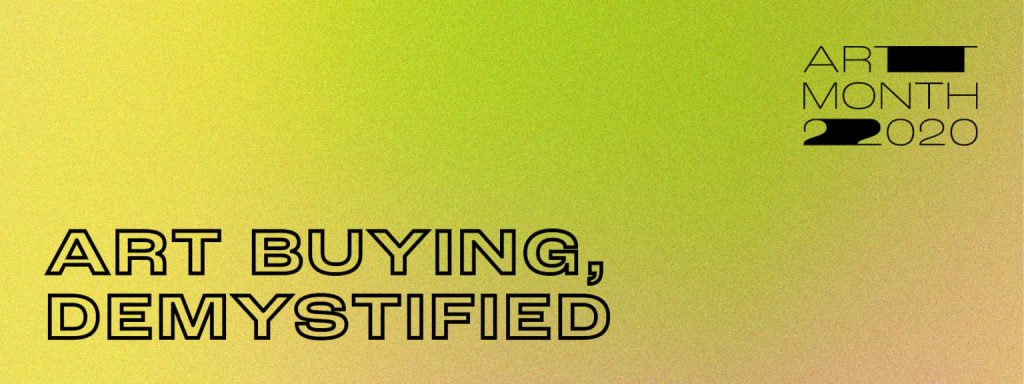Buying Art, Demystified

The virtual adaptation of this year’s Art Month allowed us to shine a spotlight on the talented individuals shaping the District’s art scene and expand the dialogue around the art community beyond Hickok Cole’s doors. Through a three-part webinar series, we invited key stakeholders in the art world – from curators and artists to developers and more – with diverse backgrounds and perspectives to comment on art’s unification qualities and identify the ways in which it impacts our society on a daily basis.
Our second Art Month panel, Buying Art: Demystified, focused on making the art buying process more approachable for novel collectors. From assessing quality and determining your style to spotting up-and-coming artists, DC creatives and art experts shared insight on building your collection while reflecting on the value of art beyond the physical object. Host Laura Ewan, Marketing and Communications Director at Hickok Cole was joined by Schwanda Rountree, Founder of Rountree Art Consulting, Philippa Hughes, Founder of Curiosity Connects Us, Angie Shah, Director of Marketing at Shah & Shah Jewelers, and Regan Billingsley, Founder of Regan Billingsley Interiors.
If you missed the conversation, don’t worry. You can revisit the recording, or read on for our top three takeaways from Art Buying, Demystified.
Understand what value means to you
Like with most big purchases, you have to do your research before pulling the trigger. Whether through Instagram or by visiting galleries, increased exposure to a wide variety of art is the best way to identify what style and mediums you’re most attracted to–and what you’re willing to spend.
“For some of my more novel collectors, the decision making factor is definitely budget driven,” says Schwanda Rountree, Founder of Rountree Art Consulting. “But, as a consultant, my primary role is to educate the client on what it is they’re purchasing, especially when justifying a larger price tag.” Apart from aesthetic, Schwanda says one thing to consider is sustainability. “It’s important for me to know that this artist is dedicated to their craft and their success isn’t fleeting,” she reflects, adding that if artists have shown in institutions, museums, or certain private collections, that up-ticks the value of their work.
Angie Shah, Director of Marketing at Shah & Shah Jewelers approaches her art collecting with a long-term perspective. “The longevity factor is important to me,” she shares. “I ask myself, is this going to continue to inspire me and challenge me? Can I live with this for the rest of my life?” She advises that new collectors look for artists with a distinct point of view and one that matches their own. “Every piece should be a reflection of someone’s taste, likes, and how they live.”
The bottom line is art buying is a personal process and ultimately we determine the value of having art in our homes. “We all have limited budgets but I chose to put my disposable income towards buying art,” says Philippa Hughes, Founder of Curiosity Connects Us. “You have to decide for yourself, How much of a priority are you going to put on this in your life? How much is it worth to you outside of the monetary value?”
Investing in art goes beyond the physical object
Buying a piece of art is an investment. But you’re not just investing in your happiness or the decor in your home. Your purchase has a direct impact and is a reflection of your values. “It’s bigger than just buying something. I’m an advocate for artists and believe in supporting their livelihood,” says Schwanda. “I have a pretty diverse collection in terms of medium but the common thread throughout is that all the works are made by Black artists and that’s important for me because Black artists are underrepresented in the collecting realm as well as in institutions.”
When you purchase a work of art, you’re investing in that artist, their profession, and the community they’re a part of. “Maybe your investment actually helped pay their rent that month,” Philippa says. “Even buying art at a lower level helps allow that artist to continue creating.” And while art is everywhere these days, rather than purchasing a commercial print, buying locally has an authenticity component to it as well as a higher level of transparency. “I see a lot of cultural appropriation in design and in art. When looking to add a new work to your collection, it’s important that you understand where it’s coming from and are sure the artist is being compensated appropriately,” adds Regan Billingsley, owner of Regan Billingsley Interiors.
Resist the urge to impulse-fill your white space
What comes first, the art or the interior design? According to Regan, both can be true. A piece that holds a lot of value for a client might determine how a particular space is designed. “I recently had a client who had a bunch of old charcoal drawings of New York that we transformed into panels as custom wallpaper in her elevator.” At the opposite end of the spectrum, Angie shared her husband’s recent experience. “Having moved into an office space where the walls were dark grey, he commissioned two large charcoal works of clouds specifically to contrast the office design.”
Whether or not you’re remodeling or just moving into a new space, Regan said to embrace the white space and be patient until you find something that you love to fill it. “I might sit with a dining room table without chairs for six months before I find the right fit. And that’s the same way I approach art.” She emphasized how possible it is to make an impact with just one special piece. “Back up in the space, look at your focal points and really work with that. You can have an entire room centered around just one piece if it elicits joy, especially if you’re working from home. Everything in your space should feel meaningful.”


